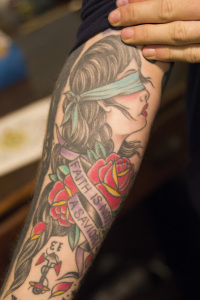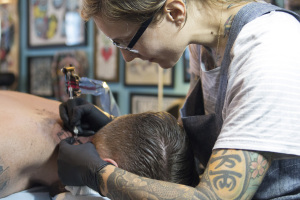

While tattoos have been popular for thousands of years, they are now as common as an individual’s personal style. Many wouldn’t dare to include tattoos with other prestigious art forms such as painting or sculpture.
Ricky Havoc and Danielle Distefano are both tattoo artists who disagree. They believe many are not aware of the skill that goes into tattoo art.
Ricky Havoc, nick-named “Ricky Horton” is an artist at City of Ink Tattoo, a respected and loved parlor on Walker Street.
Havoc started tattooing seven years ago and while he never had a formal apprenticeship, he still managed to rise as a tattoo artist.
While tattoos are on par with other art forms, many come with certain stereotypes about them.
“If you have tattoos you must be some type of heathen,” Havoc said. “Especially if you’re a doctor or a lawyer or a public official.”
On the other side of Atlanta, Danielle Distefano is the co-owner and artist at Only You Tattoo, located on Memorial Drive.
“I started getting tattooed before I knew I was interested in becoming a tattoo artist,” Distefano said. “While hanging out at the shop and collecting more and more tattoos, I realized it was something that I was interested in figuring out.”
“I learned a lot from the tattooers. I was getting work from and had a lot of encouragement from them to pursue tattooing,” she continued. “I read up on the history, studied the styles, practiced drawing flash designs, until I started to work in a shop and was offered an apprenticeship.”
Danielle did her share of grunt work before she was given the chance to work with clients. After putting in the drawing practice, watching other tattooers, and drawing some more, she got solid work.
“I had the great pleasure of learning from another woman, Kate Hellenbrand,” Distefano. “I think that was really helpful to get started in a male dominated industry and get the perspective of a female who had been working in it for over 25 years.”
“I definitely had an easier time as a woman getting started than Kate did, and women now have a much easier time gaining the respect of the industry and the client then I did,” she explained. “We are constantly learning and growing.”
THE PROCEDURE
The clients range from walk-ins to appointments, and whichever artist is up for it or free can take the job making the art.
Depending on the size and detail, pieces can take from 30 minutes to many hours.
The step to step details include:
1. Once the artist is assigned, the idea that the client wants is discussed with the artist and a final interpretation is settled upon.
2. The artist makes a stencil of the artwork, whether they use carbon paper or simply a Sharpie.
3. The area is cleaned and sterilized so the stencil can be placed and reworked.
4. The actual process of placing the artwork can go very different ways. Some artists begin with line work for example, where they outline all of the lined details on the piece, whatever it may be.
5. There are many different styles that influence how they begin.
“Realistic, American traditional (or Old School), Japanese, new school, black and grey, and Tribal are the major [styles] that are used today,” Distefano said.
WHAT IT TAKES
When it comes to tattoo artistry, both artists agree the skills each artist possesses are his or her greatest assets.
“Without a doubt tattooing is in the art realm,” Distefano said. “Even the beginnings of tattooing were creative, expressive and making a statement.”
“The technique has become more advanced and things can be done that I’m still shocked are done, but it has always been art even if the art world didn’t recognize it at first,” she continued. “The idea of a tattoo offending someone should have been the first clue that it was art.”
Havoc said tattoo techniques are similar to techniques used with art mediums.
“If you can’t draw, you shouldn’t be doing this at all. You need to able to draw and paint,” Havoc said.
While the ability to create art is essential, having interpersonal skills is essential in communicating with clients.
“From a technical standpoint, knowing how to simply draw might work out, but from a mental standpoint you need to be able to deal with what we deal with on a daily basis,” Havoc said.
According to Havoc, the right temperament and people skills are essential.
“You’re coming into contact with all sorts of people; from people who have never had a tattoo before and are really sweet, to hardcore people who just want a piece done and don’t know how to act,” Havoc said.
Thinking on your feet is a trait highly coveted by artists, because some pieces don’t go according to plan. Being able to work smartly with the client is necessary for the process to benefit both parties.
“Tattooers work in the same capacity as many other artists, but with the added pressure of dealing with the clients ability to sit still, and having their input throughout the whole process,” Distefano said. “It gets critiqued and commissioned like any other form of art.”
Also, having a respect for permanently marking someone is required. The clients that are coming in are coming for various reasons, while some are more personal than others.
“They don’t realize it, but you’re playing therapist for them. A lot of the people that come by, there’s reason for them,” Havoc said. “Not always just because it looks cool, but that it holds a meaning to them. So when they’re in the chair you can kind of get to pick their brains and find out what kind of person you’re sitting with.”

PHOTO BY NADIA DELJOU | THE SIGNAL
TATTOO COMMUNITY IN ATLANTA
Over the last 10 years, tattoo communities in general have expanded and become more popular.
“Especially with the tattoo shows that are popular. It’s getting a lot more exposure to sway the public eye,” Havoc said. “It’s considered a rite of passage once you hit the legal age. In Atlanta, it’s diverse in the terms that you have different shops and different levels of shops in terms of quality.”
These are the highly rated and popular parlors in the city:
· Memorial Tattoo
· Liberty Tattoo
· City of Ink
· Only You Tattoo
· Southern Star Tattoo
· 13 Roses
(To see the location of these parlors, visit: https://www.google.com/maps/d/edit?mid=zASs-XY4h1Rk.kCHm_6jSoQr8)

PHOTO BY RUTH PANNILL| THE SIGNAL
TIPS FROM ARTISTS
· Listen to your artist – There are usually reasons for their recommendations, and want to make sure that what they give you will look good, heal and be loved by the client. “People just don’t listen to what we recommend,” Distefano said.
· Moisturize smartly – “Don’t make it something very heavy or thick. Plain white lotions will, however, get the job done,” Havoc said.
· Avoid direct sunlight – It will fade if not smartly covered with sun protection.
· Avoid finger tattoos – “They don’t heal well. It’s a very small area and attempting to do stuff such as words on fingers isn’t good,” Havoc said. “Ink spreads in the body over time and something can begin to look very splotchy and spread out. It can go from a word to a blob. If you want details, you need a lot of space.”
· Coordinate colors and details based on your skin tone. “The darker you are the larger the tattoos need to be to allow contrast.” Havoc said. “Some certain designs and shades simply don’t look good on different skin tones.”
· Don’t come in with unrealistic expectations – If you give your idea to the artist and it’s something that won’t work based on the placement or the colors, try not to get too upset. Come in with a vague expectation and be prepared to go back and forth with the artist.
· Do your research and prep – “If you are looking to get a tattoo, do your research, look at the style of the artist, meet the artist, and make your decision based on your experience with them and the shop,” Distefano said.
· Don’t get too worked up over the “pain” – “People think a tattoo machine is called a gun. Tattoos do hurt somewhat, but they are bearable and well worth the effort it takes to get one. Don’t be so nervous,” Distefano said.
